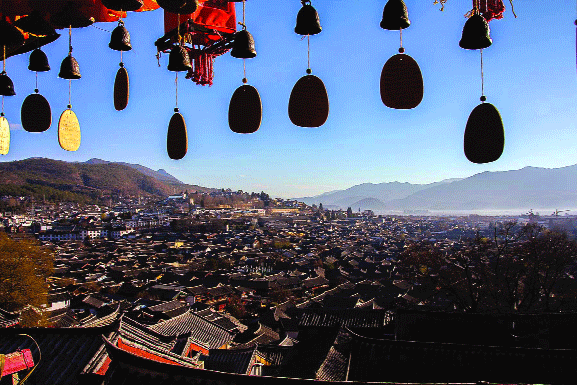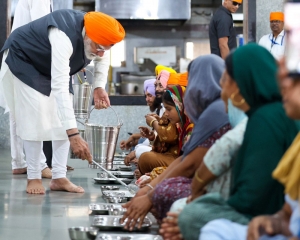The liberation of Tengchong and its significance in the China-Myanmar-India theatre of the Second World War may have become a forgotten episode for the people outside Yunnan. But the memories of the war still evoke strong emotions among the local people
legends of history can sometimes be found in places which otherwise remain unknown to the world outside, such as the remote towns in Yunnan along the China-Myanmar border. Tengchong is a faraway hill town nestled in scenic mountains, forests and hot springs. Fabled for its exquisite jade, old-style Chinese homes, and expanse of farmland, the town can be an epitome of serene bliss for any visitor. It is often referred as a tourist destination for the whole 365 days in a year. It is difficult to imagine that seventy years ago this quiet old town and her farm folks suffered the brunt of Japanese invasion and they fought a valiant battle and chased the aggressor thus liberating the town. The local legend is that the liberation of Tengchong and the crushing defeat of Japanese is a turning point in the course of the war in China-Myanmar-India theatre. For Tengchong people, this history still lingers as strong emotive memories which they preserve for generations to come and witness and learn not to forget.
In local parlance, Tengchong is known as Biancheng Zhen (border town) connecting Yunnan and India through Myanmar. Tengchong has recently been added in the official list of border economic zone. The drive is to make Tengchong as an important trade centre connecting South Asia and Southeast Asia. It is closer to the places and towns across the border as it connect Yunnan with Myitkyina in Myanmar. Tengchong lies 200 km from Mytkyima and nearly 600 km away from ledo, India. This geographical position makes it an important gateway of China to South Asia and South East Asia.
The folklore in Tengchong narrates that the prosperity of 6,00,000 people residing in this area depends on the possibility of constructing a highway connecting Yunnan and India through Tengchong. The city has already constructed a second grade highway between Tengchong and Mytikima in Myanmar after the continuous efforts by the then Party Secretary of this region. In theory, Tengchong is situated in the economically most viable location as far as connecting (ledo) India and (Yunnan) China by road is concerned. India gains a very important position in the eyes of people as the ray of prosperity and wealth.
local history records that Tengchong used to be a strategic passage and communications hub of the Silk Road of the ancient southwestern China. Tengyue (the earlier name of Tengchong) has been referred as an ancient town in Dianyue (earlier name of Yunnan). Zhang Qian, the great explorer, diplomat and traveller passing through the southwest Silk Road did not cross Yunnan and could not come to India. But He Shun (ancient merchant town) has witnessed a good expansion of trade in Ming dynasty. In 1899, England established its consulate at Tengchong. In 1902, the Qing Government established Tengyue customs here. The people of Tengchong first discovered the market value of emeralds and were the first ones to start processing of jade. Jade processing has a history of more than 600 years now. Since the ancient times till present, Tengchong has all along been an important jade processing trading and distribution centre of South East Asia.
Tengchong was major site of the China’s resistance war against Japanese invasion as an important Burma Road was built during the Second World War here. In the situation where the Japanese controlled most of the sea ports and cities of China, it was difficult for the American forces supporting the Kuomintang to provide military supplies in China. The Burma Road acquired a strategic importance in this context. The road used to transport military supplies to Kunming, Yunnan and other parts of China. The Burma Road is actually formed of two roads: one stretching 600 miles long built in 1937-38 between lashio, Burma and Kunming, China. It was basically to help Chiang Kai-Shek bring supplies through a backdoor of China after the Japanese invaded China; secondly, the straight lines built from ledo to Kunming, which is about 460 miles. The Burma and ledo Roads were built through the world’s most difficult terrain of China-India and Myanmar. Kunming in Yunnan was the main distributing point for the supplies which were coming from the Burma and ledo Roads. It was the leadership of General Stilwell, the commander of American troops in China-Myanmar-India region. In China, the Burma and ledo Roads are known as the Stilwell Road.
Stilwell’s troops invaded Myanmar from India in October 1943, the Japanese Army was defeated at the battles of Kohima and Imphal by the British forces and Stilwell forces fought a fierce battle against the Japanese to defend Myitkyina, which lasted for ten weeks from May-August in 1944. Chinese troops in a way fought under the US command. Tengchong became a battlefield when the Japanese imperial army invaded and occupied the Western Yunnan from Myitkyina in 1942. For the next two years, there was a war of resistance from China. The largest part of such war of resistance in Western Yunnan was to regain control of Tengchong town. When the Japanese invaded Tengchong from Myitkyina in Myanmar, they passed through and attacked villages and townships dominated by ethnic minorities like lisu, Dai, Wa and Anchang. Tengchong became the important battleground in the war of resistance in the Western Yunnan. It was only in September 1944, the Chinese expeditionary forces could recover this area.
The liberation of Tengchong and its significance in the China-Maynmar-India theatre of the Second World War may have become a forgotten episode for the people outside Yunnan. But the memories of the war still evoke strong emotions for the local people. Tengchong is an important fortification at the borders. It geographical location and specialty given the place a very critical role to play in military affairs. On September 14, 1944, the common people of the entire place, the self-defence force of the region and the expeditionary force came together to attack the Japanese forces at Tengchong. After a bloody war that lasted for 127 days, Tengchong was finally redeemed. More than 6,000 enemies, 9,168 people from the expeditionary force and 19 people from the allied forces of officers were killed in the war. This history of war of resistance is both inspiring and tragic at the same time. It reminds people and plays clippings of series of historic events in their minds: China-India highway and expeditionary forces, Tuofeng air route and flying tigers, the commissioner of the war of resistance Zhang Wende, the mausoleum of war heroes, etc.
To commemorate those soldiers who had sacrificed their lives, the Government has constructed the Cemetery of National Martyrs over an area of 10,000 sq metres. Souls of 9,000 soldiers of the expeditionary force who laid down their lives to recover the territory of Tengchong rest here. This cemetery was built in June 1956. At present it is the largest and well-protected frontline battlefield mausoleum for martyrs of the war of resistance.
Heading upward of this cemetery, there is a memorial compound with a small hall bearing the flags of the Guomindang and a portrait of Chiang-Kai-Shek. It is one of rarest phenomena showing respect to Republican flag which today is the flag of Taiwan. There are large numbers of tombs of Chinese soldiers arranged in a rank and file with names imprinted on those. It was these soldiers who prevented Japan from intruding China from the south west. There are more than 3,000 small headstones with the rank and names of those who lost their lives in the fierce battles for Tengchong that were crucial in preventing China’s collapse. Today, the Martyrs Cemetry on Songyuan lu is a reminder of the great sacrifices made by Chinese soldiers almost 70 years ago in Tengchong.
(The writer teaches at the School of International Studies, Jawaharlal Nehru University, New Delhi)


























